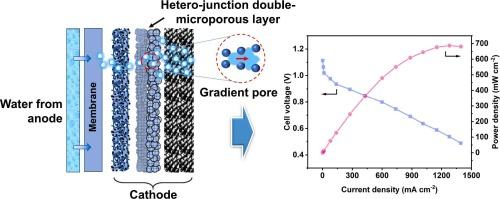Boosting the power density of direct borohydride fuel cells to >600 mW cm−2 by cathode water management
IF 10.1
1区 工程技术
Q1 ENERGY & FUELS
引用次数: 0
Abstract
Direct borohydride fuel cell (DBFC) has garnered significant interest due to its high energy density. However, the power density remains insufficient for commercial applications. Lots of works have been conducted on the kinetics of the anode reaction, while little attention has been devoted to cathode water management which is important issue for direct liquid fuel cell. Herein, a new structure gas diffusion layer (GDL) with hetero-junction double microporous layer (HJD-MPL) is developed. Utilizing the HJD-MPL structure, achieving a peak power density of 688 mW cm−2 at 80 °C, which exceeds the literature reports (453 mW cm−2). With higher porosity, permeability and stronger gradient capillary force, the oxygen transfer resistance is reduced from 75.5 s cm−1 of commercial GDL to 24.4 s cm−1. This study offers new insight into DBFCs, emphasizing cathode engineering to advance more effective and reliable direct liquid fuel cell technologies.

通过阴极水管理将直接硼氢化燃料电池的功率密度提高到 >600 mW cm-2
直接硼氢化燃料电池(DBFC)因其能量密度高而备受关注。然而,其功率密度仍不足以满足商业应用的需要。人们对阳极反应动力学进行了大量研究,却很少关注直接液体燃料电池的重要问题--阴极水管理。在此,我们开发了一种具有异质结双微孔层(HJD-MPL)的新结构气体扩散层(GDL)。利用 HJD-MPL 结构,在 80 °C 时达到了 688 mW cm-2 的峰值功率密度,超过了文献报道(453 mW cm-2)。由于具有更高的孔隙率、渗透性和更强的梯度毛细力,氧气传输阻力从商用 GDL 的 75.5 s cm-1 降至 24.4 s cm-1。这项研究为 DBFCs 提供了新的视角,强调了阴极工程,以推进更有效、更可靠的直接液体燃料电池技术。
本文章由计算机程序翻译,如有差异,请以英文原文为准。
求助全文
约1分钟内获得全文
求助全文
来源期刊

Applied Energy
工程技术-工程:化工
CiteScore
21.20
自引率
10.70%
发文量
1830
审稿时长
41 days
期刊介绍:
Applied Energy serves as a platform for sharing innovations, research, development, and demonstrations in energy conversion, conservation, and sustainable energy systems. The journal covers topics such as optimal energy resource use, environmental pollutant mitigation, and energy process analysis. It welcomes original papers, review articles, technical notes, and letters to the editor. Authors are encouraged to submit manuscripts that bridge the gap between research, development, and implementation. The journal addresses a wide spectrum of topics, including fossil and renewable energy technologies, energy economics, and environmental impacts. Applied Energy also explores modeling and forecasting, conservation strategies, and the social and economic implications of energy policies, including climate change mitigation. It is complemented by the open-access journal Advances in Applied Energy.
 求助内容:
求助内容: 应助结果提醒方式:
应助结果提醒方式:


